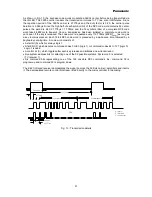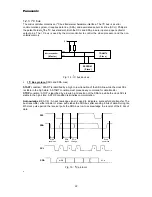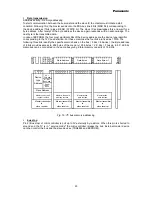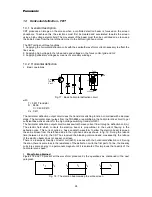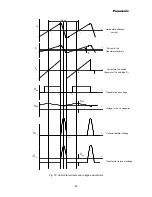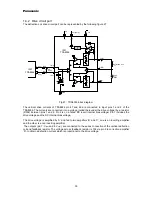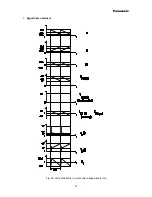
3DQDVRQLF
16
ident stage of the Automatic System Manager (IDS signal). The H/2 switch distributes the
demodulated signal to the (R-Y) and (B-Y) amplifiers and via the PAL/SECAM switch (PS) to the
baseband delay line. The bypass mode of the delay line is not possible for SECAM.
The V
INT
and U
INT
signals from delay line outputs are fed to the YUV selection circuit (see YUV/RGB
processing part).
* ASM ( Automatic System Manager )
The ASM is field synchronous; it can identify PAL/NTSC/SECAM color standards. The different
possibilities are controlled by the I²C bus input commands (CM2 --> CM0) . These input commands
are communicated to the ASM via the I²C bus.
The I²C bus input commands (XA, XB) , also supplied to the ASM via the I²C bus, indicate which Xtals
must be connected to pins 34 and 35. This is essential for correct calibration of the horizontal
oscillator.
The I2C command FCO disables the color killer in forced modes only and allows maximum color
sensitivity. (see also I²C bus description).
For color identification purposes there is also communication with the ASM and:
- the PAL/NTSC ident circuits (IDP, IDN)
- the SECAM ident (IDS)
- the VCXO via xtalswitch (XTS)
- the PAL/SECAM switch (PS)
- the R-Y demodulator (H/2)
The I²C output commands (SXA, SXB) indicate whether the (XA, XB) bits have been correctly
transmitted by the I²C bus. The I²C output commands (CD2 --> CD0) indicate which color system has
been identified.
* The (B-Y)/(R-Y) demodulation
The (B-Y)/(R-Y) baseband signals are extracted from the chroma signal by the (B-Y)/(R-Y)
demodulators, filtered and supplied via the output switch to pins 29 and 30 respectively. For correct
demodulation of (R-Y) PAL signals, then the demodulated (R-Y) signals requires 180" phase reversal
on alternate lines, this is realized with the PAL switch
The demodulator gain ratio (B-Y)/(R-Y) is typically 1.78 in order to compensate far scaling in the
transmitter. During the line/field blanking periods of the sandcastle pulse the (B-Y)/(R-Y) are blocked ;
then the correct DC levels are supplied to the (B-Y)/(R-Y) outputs.
When SECAM is identified by the SECAM add-on decoder and no PAL/NTSC is already identified by
the ASM, then the ASM sets the (B-Y)/(R-Y) switch open via (DEMSW). This implies that the (B-Y)/(R-
Y) signals from the SECAM decoder can be directly connected to pin 29 and 30 respectively without
extra loading.




















